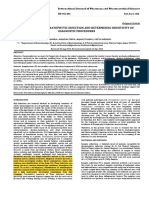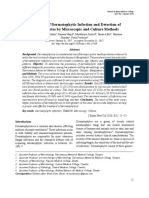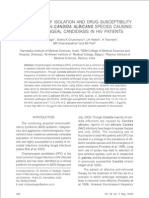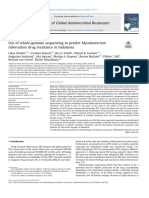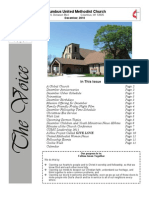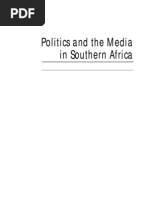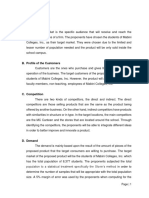Dermatophytosis in Bhairahawa, Nepal: Prevalence and Resistance Pattern of Dermatophyte Species
Dermatophytosis in Bhairahawa, Nepal: Prevalence and Resistance Pattern of Dermatophyte Species
Uploaded by
Subhas KarnaCopyright:
Available Formats
Dermatophytosis in Bhairahawa, Nepal: Prevalence and Resistance Pattern of Dermatophyte Species
Dermatophytosis in Bhairahawa, Nepal: Prevalence and Resistance Pattern of Dermatophyte Species
Uploaded by
Subhas KarnaCopyright
Available Formats
Share this document
Did you find this document useful?
Is this content inappropriate?
Copyright:
Available Formats
Dermatophytosis in Bhairahawa, Nepal: Prevalence and Resistance Pattern of Dermatophyte Species
Dermatophytosis in Bhairahawa, Nepal: Prevalence and Resistance Pattern of Dermatophyte Species
Uploaded by
Subhas KarnaCopyright:
Available Formats
Ulutas Med J 2021;7(2):115-123
DOI: 10.5455/umj.20201208055254
ORIGINAL ARTICLE OPEN ACCESS
Dermatophytosis in Bhairahawa, Nepal: Prevalence and
Resistance Pattern of Dermatophyte Species
Subhash L Karn1 · Ajay Gurung1 · Amit K Shrivastava2 · Sulochana K Poudel1
Shristi R Adhikari1 · Chandra M Sah3
1
Department of Microbiology, Universal College of Medical Sciences, Bhairahawa, Nepal.
2
Department of Pharmacology, Universal College of Medical Sciences, Bhairahawa, Nepal
3
Department of Dermatology, Universal College of Medical Sciences, Bhairahawa, Nepal
Introduction: Dermatophytosis is colonization by dermatophytic fungus of the keratinized tissues like hair, nails and
skin. They are considered important as a public health problem. The study was aimed to isolate, identify, and detect
the in-vitro antifungal sensitivity pattern of various dermatophytes isolates from clinically diagnosed cases of
dermatophytosis.
Materials and Methods: One hundred and sixty patients of all age group and both sexes and clinically diagnosed
with dermatophytosis were recruited in this study. The specimens included skin scales, hair pluckings and nail
clippings. Identification and isolation were done by microscopic examination, culture and biochemical analysis.
Results: Dermatophytosis was more common in males (60.62%) than females (39.37%). Tinea corporis (31.25%) was
the most common clinical presentation followed by Tinea faciei (25%). Trichophyton rubrum (36.19%) was the most
common isolate followed by Trichophyton mentagrophytes (15.23%). Out of four antifungal drugs used, fluconazole
was found most resistant while Itraconazole was most effective drug.
Conclusion: The epidemiology of dermatophyte infections may change with time. Antifungal susceptibility testing
will aid the clinician in initiating prompt and appropriate antifungal therapy and prevent emergence of resistance.
Keywords: Antifungal sensitivity, dermatophytosis, tinea infection, trichophyton
Introduction (human), zoophilic (animals), or geophilic (soil)
Dermatophytes are keratinophilic hyaline molds origin. These organisms are named according
that can cause disease in keratinized tissues to the affected body site: Tinea capitis (head),
like hair, skin, and nail (1). The members of T. corporis (trunk), T. cruris (perianal area),
this dermatophytic group include Trichophyton, T. pedis (foot and interdigital area), and
Microsporum and Epidermophyton (2). Based T. unguium (nail) (3). The most common
on the reservoir and route of transmission, etiological agents are Trichophyton rubrum, T.
dermatophytes may be of anthropophilic mentagraphytes, T. interdigitale, T. tonsurans,
Corresponding Author: Subhash Lal Karn; Department This is an Open Access article distributed under
of Microbiology, Universal College of Medical Sciences, the terms of Creative Commons Attribution Non-
Bhairahawa, Nepal Commercial License, which permits unrestricted
E-mail: subas_karna@yahoo.com non-commercial use, distribution, or reproduction
ORCID: 0000-0002-5436-0330 in any area, original work is properly cited.
Received: Dec 8, 2020 Accepted: May 4, 2021
Published: June 26, 2021 The Ulutas Medical Journal © 2021
Dermatophytosis Karn et al.
and Microsporum canis. T. rubrum is the most correlation between in vitro and in vivo action
frequently isolated agent in clinics (1). Nepal is of drugs (2, 14).
such a country where a wide variation in This study was planned to determine the
climate, socio - economic status, religion and prevalence of dermatophytes infection in
customs is quite prevalent in different parts Bhairahawa, Nepal as well as the resistance of
of the country. In developing countries, other the recovered dermatophyte species to
than hot and humid climatic conditions, low antifungal drugs. So far, skin fungal infection is
hygiene, poor access to water, overcrowding empirically treated and fungal culture and
contact also plays significant etiological role for sensitivity is not routine recommended in our
dermatophytosis (4-9). region; therefore, only handful of data is
Treatment options for dermatophytosis are available regarding incidence of skin infection
topical as well as systemic antifungal drugs. and drug resistance. Therefore, this study was
But during course of time dermatophytes have planned to find out the same.
also evolved drug resistance for single as Materials and Methods
well as multiple drug simultaneously. Studies A hospital-based prospective observational
conducted worldwide show that resistance study was conducted at Universal College of
among dermatophytes is not uncommon (10, Medical Sciences Teaching Hospital (UCMS-TH)
11). Due to high temperature and increased Bhairahawa from March 2019 to October 2019.
humidity, there are increased cases of dermato
phytosis and other fungal infections especially Ethical Statement
Ethical approval was taken from the institutional
in terrain and hilly region of Western Nepal.
review Committee (IRC) of UCMS-TH prior to
Since there was increased incidence of drug
the sample collection (I.R.C. Reg. No. UCMS/IRC
resistance observed over a period of time to
/036/019). A total of 160 patients of all age
the antimycotic drugs commonly used for
group and both sexes attending Dermatology
the treatment i.e., fluconazole, terbinafine
outpatient and clinically diagnosed with
and clotrimazole, the need for testing of
dermatophytosis were recruited in this study
antifungal susceptibilities of dermatophytes has
after informed consent. Patients with surface
become apparent. Recently CLSI (Clinical and
infections, accidental and surgical cases and
Laboratory Standards Institute) has approved a
also patients who were already on antifungal
micro broth dilution method for antifungal
treatment were excluded from the study. A
susceptibility testing of molds, but these tests
detailed history of selected cases was recorded
are cumbersome and difficult to be performed
that included name, age, sex, address, duration
in routine laboratory setup. The agar-based
of illness and other complaints. All the clinically
disc diffusion (ABDD) is an easy method
diagnosed 160 cases were subjected to
to determine the antifungal susceptibility of
mycological work. The specimens included skin
dermatophytes, but data regarding these
scales, hair and nails. The site of the lesions was
methods are scarce and not standardized (2, 12,
cleaned with 70% alcohol, samples were
13). The application of in vitro antifungal
collected in a sterile paper folds and labelled
susceptibility testing for guidance of antifungal
with details of patients. All the samples were
drug therapy has been limited due to uncertain
116 Ulutas Med J 2021;7(2):115-123
Dermatophytosis Karn et al.
subjected to direct microscopy and culture. applied over MHA plates, after which the plates
One part of the specimen was directly observed were incubated at 280 C for 5-7 days.
under microscope by potassium hydroxide Trichophyton mentagrophytes ATCC 9533 and
(KOH) mount using 10% for skin and 40% Trichophyton rubrum ATCC 28188 strains
for hair and nail samples. Another part of the served as control. After the colonies grew, the
sample was inoculated on slants of Sabouraud’s zones of inhibition around the disc were
dextrose agar (SDA) with chloramphenicol measured in millimeters and recorded as
(0.05 mg/ml) and cycloheximide (0.5mg/ml). sensitive, intermediate or resistant (9, 12, 13).
Culture tubes were examined thrice weekly Control plates with fungus inoculum and
for appearance of growth, cultures were without antifungal disc were also tested.
incubated for 1 month before discarding All the data from cases was fed in MS Excel
them as negative. Cultures yielding growth (Microsoft office 2018) and then analyzed by
were evaluated to species level-based colony
Statistical Package for Social Service (SPSS) for
morphology, microscopic properties in Lacto window version; SPSS 22, Inc., Chicago, IL). All
phenol cotton blue (LPCB) mount and urease
data were expressed in terms of percentage.
test. The LPCB was obtained from Hi-Media
Laboratories Pvt. Ltd., Mumbai, India. The Results
isolates were subjected to the agar-based disc Out of 160 clinically diagnosed cases of
diffusion method to the study of sensitivity dermatophytosis, males (60.62%) were more
pattern of antifungals using antifungal drugs as affected than females (39.37%) with male:
described by Nweze et al, (12) and Prabhat female ratio 1.54:1. Most of the affected patients
Kiran Khatri et al.(15). All the dermatophytes belonged to the age group of 15-29 years
were sub cultured on potato dextrose agar (33.75%) followed by 30-44 years (26.87%)
and incubated at 280C to enhance sporulation which is shown in Table-1. Majority of
for 1 week. Following growth, conidia were the affected patients belonged to low socio
harvested in sterile saline and conidial economic status and were involved in active
suspension was adjusted to between 1.0×106 physical works like manual laborer, farmers,
and 5×106 spores/ml by microscopic carpenter, tailor, domestic help etc.
enumeration with cell counting hemocytometer Table 1. Distribution of patients according to age and sex
(Neubauer chamber) (16). Four antifungal drugs Age group Males Females Total
were tested against dermato phytes isolates. (in years)
The following commercially available antifungal 0-14 11 (6.87%) 7 (4.37%) 18 (11.25%)
drugs were obtained from HiMedia Laboratory 15-29 31 (19.37%) 23 (14.37%) 54 (33.75%)
Pvt. Ltd., Mumbai, India; fluconazole (25 µg), 30-44 24 (15%) 19 (11.87%) 43 (26.87%)
itraconazole (10 µg) and ketoconazole (10µg). 45-59 18 (11.25%) 9 (5.62%) 27 (16.87%)
Plates of non-supplemented Muller Hinton >60 13 (8.12%) 5 (3.12%) 18 (11.25%)
Agar (MHA) were streaked evenly in three N1 = 97 N2 = 63 N = 160
Total
directions with a sterile cotton swab dipped into (60.62%) (39.37%) (100%)
the standardized inoculums suspension. Plates Tinea corporis (31.25%) was the most common
were allowed to dry then antifungal disc were clinical presentation followed by Tinea faciei
117 Ulutas Med J 2021;7(2):115-123
Dermatophytosis Karn et al.
(25%) and Tinea capitis (14.37%). There was most common isolate followed by Trichophyton
higher incidence of Tinea corporis and Tinea mentagrophytes(15.2%),Trichophyton tonsurans
faciei in males compared to females i.e. 27 (13.3%) and Trichophyton violaceum (12.4%).
(16.87%), 22(13.75%) respectively which is shown Trichophyton rubrum was the most common
in Table-2. dermatophyte isolated from 38 clinical
Table 2. Distribution of clinical types of dermatophytosis
types of dermatophytosis. All four isolated
Clinical Types Males Females Total
dermatophyte species were recovered from
Tinea corporis, the most common clinical
Tinea Corporis 27 (16.87%) 23 (14.37%) 50 (31.25%)
presentation which is shown in Table-4.
Tinea Faciei 22 (13.75%) 18 (11.25%) 40 (25%)
Antifungal susceptibility testing showed
Tinea Barbae 13 (8.15%) 0 13 (8.12%) itraconazole as the most sensitive antifungal
Tinea Capitis 12 (7.5%) 11 (6.87%) 23 (14.37%) agent, while ketoconazole was the least
sensitive. Among the dermatophyte isolates, M.
Tinea Pedis 10 (6.25%) 4 (2.5%) 14 (8.75%)
audouinii showed 100% sensitivity against
Tinea Unguium 7 (4.37%) 3 (1.87%) 10 (6.25%) Itraconazole followed by T. rubrum (84.21%)
Tinea Cruris 6 (3.75%) 4 (2.5%) 10 (6.25%) whereas the least sensitivity was shown by M.
canis (55.56%). T. mentagrophytes showed
Total 97 (60.62%) 63 (39.37%) 160 (100%)
68.75% sensitivity against fluconazole. Similarly,
Out of 160 samples processed, 130 (81.3%) T. violaceum showed highest sensitivity i.e.,
were positive for KOH mount while 105 (65.6%) 76.92 % against ketoconazole followed by T.
were culture positive. Out of 130 KOH positive tonsurans (71.43%) and T. mentagrophytes
samples, 102 (63.8%) were both KOH positive (62.5%) which is shown in Table-5.
and culture positive, rest were culture negative
which is elucidated in Table-3.
Table-3. Correlation between results obtained by direct
microscopy (KOH mount) and culture
KOH Number of cases
Culture Culture
Results Total
(+ve) (-ve)
KOH
102 (63.75%) 28 (17.5%) 130 (81.25%)
(+ve)
KOH
3 (1.88%) 27 (16.88%) 30 (18.75%)
(-ve)
Total 105 (65.62%) 55 (34.37%) 160 (100%)
Samples from patient with Tinea cruris resulted Figure 1. Clinical Pictures of Dermatophytosis Infection. A
100% KOH positivity followed by those from (Tinea faciei showing erythematous annular lesions with
cases of Tinea capitis which showed 78.26% central clearing), B (Annular erythematous scaly plaques
with advancing margin of tinea corporis), C (Tinea capitis
KOH positivity. Highest cultural positivity was showing patch of alopecia and ring formation at
observed in cases of Tinea corporis (74%) the periphery), D (Destruction of nail plates due to
Tinea unguium). E (Tinea barbae showing erythematous
followed by Tinea faciei (70%) and Tinea barbae annular lesions over bearded skin); F(Tinea cruris with
(61.5%). Trichophyton rubrum (36.2%) was the erythematous lesions at groin region).
118 Ulutas Med J 2021;7(2):115-123
Dermatophytosis Karn et al.
Table 4. Correlation between clinical presentations and isolated dermatophytes
Dermatophyte isolated
Clinical KOH Culture
Diagnosis Positive Positive M. T. mentagro T.
E. floccosum M. audouinii T. tonsurans T. violaceum
canis phytes rubrum
Tinea Barbae 10 8 0 0 2 0 6 0 0
Tinea Capitis 18 13 0 1 0 6 4 2 0
Tinea Corporis 41 37 5 2 4 9 5 9 3
Tinea Cruris 10 5 0 2 0 1 1 0 1
Tinea Faciei 32 28 1 1 2 0 18 2 4
Tinea Pedis 10 8 1 0 1 0 2 1 3
Tinea Unguium 9 6 2 0 0 0 2 0 2
130 105 9 6 9 16 38 14 13
Total
(81.3%) (65.6%) (8.6%) (5.7%) (8.6%) (15.2%) (36.2%) (13.3%) (12.4%)
Table 5. Antifungal susceptibility pattern of isolated dermatophytes
Antifungal T. rubrum T. mentagrophytes T.tonsurans T. violaceum M. audouinii M. canis E. floccosum
S/R
Discs (n=38) (n=16) (n=14) (n=13) (n=6) (n=9) (n=9)
S 32 (84.21%) 11 (68.75%) 12 (85.71%) 8 (61.54%) 6 (100%) 5 (55.56%) 6 (66.67%)
Itraconazole
R 6 (15.78%) 5 (31.25%) 2 (14.28%) 5 (38.46%) 0 4 (44.44%) 3 (33.33%)
S 7 (18.42.3%) 5 (68.75%) 2(14.28%) 3 (23.07%) 2 (33.33%) 4 (44.44%) 6 (66.67%)
Fluconazole
R 31 (81.57%) 11 (31`.25%) 12 (85.71%) 10 (76.92%) 4 (66.67%) 5 (55.56%) 3 (33.33%)
S 19 (50%) 10 (62.5%) 10 (71.43%) 10 (76.92%) 1 (16.67%) 5 (55.56%) 2 (22.22%)
Ketoconazole
R 19 (50%) 6 (37.5%) 4 (28.57%) 3 (23.08%) 5 (83.33%) 4 (44.44%) 7 (77.78%)
Discussion 160 patients, 97 (60.62%) were males and 63
Identification of species responsible for the (39.37%) were females, with male to female
dermatophytoses and their sensitivity pattern ratio being 1.54:1. Male dominance is reported
is of great importance not for epidemiology in many places of South Asia (21-23). High
but also for therapeutic point of view. Our study prevalence of dermatophytes in males is due to
site bears tropical climate where high level of frequent interaction with the society.
humidity and high temperature favor the The predominant of clinical manifestations
growth of fungi causing dermatophytoses. of dermatophytoses vary considerably to
In our present study about 33.75% of dermato different studies in literature. In this study
phytes were isolated from patient belonging tinea corporis was the most dominant clinical
to the age groups 15-29 years age. Our results manifestation involving 31.25%. Our findings
are similar to other studies (17-20) who also are in accordance with the study by Balakumar
reported higher infections in young adults. The S and et al, (24) who also reported Tinea
higher prevalence is mainly due to the physical corporis as the dominant clinical diagnosis.
activity, hot humidity and high temperature in High rates of Tinea corporis could be attributed
the region. This leads suitable wet condition to its symptomatic nature (pruritus) which
for dermatophytes to grow. In this study, out of leads the patient to seek medical advice
119 Ulutas Med J 2021;7(2):115-123
Dermatophytosis Karn et al.
(5).Whereas study by Hemendra Kumar Sharma by Trichophyton mentagrophytes (15.23%)
et al, (25) showed Tinea unguium as the Trichophyton tonsurans (13.33%), Trichophyton
dominant clinical diagnosis. This variation violaceum (12.38%), Microsporum canis (8.57%).
observed in the clinical type of dermato The other species isolated was Microsporum
phytoses is due to varied climate conditions, audouinii, and Epidermophyton floccosum.
livelihood, type of occupations, type of Our findings are in accordance with study
occupation, pathogen and host relationship. by Dhyaneswari GP et al, (27) (Trichophyton
In the study, out of 160 clinical samples, rubrum 59.6%, Trichophyton mentagrophytes
130 (81.25%) samples were positive by direct 26%), Walke HR et al, (31) (Trichophyton rubrum
microscopy by KOH mount and 105 (65.62%) 56.37%, Trichophyton mentagrophytes 19.39%),
samples were culture positive. Out of 130 KOH R.K Agarwal et al, (32) (Trichophyton rubrum
positive samples, 102 (63.75%) samples were 42.63%, Trichophyton mentagrophytes 41.81%),
both KOH positive and culture positive, while and Basak P et al, (26) who have reported
the rest 28 (17.5%) were culture negative. dermatophyte Trichophyton rubrum as the
The direct microscopy and culture findings of dominant species. However, there are studies
present study are relatively in agreement such as by Hemendra Kumar Sharma et al, (25)
with study done by Basak P et al, (26) (71.1% who has reported Trichophyton mentagro
KOH positive and 59.8% culture positive), phytes as most common species isolated.
Dhyaneswari GP et al, (27) (72.6% KOH positive) The determination of in-vitro antifungal
and Mahale RP et al, (28) (61.01% culture susceptibility was reported to be important
positive). There is a difference between KOH for the ability to eradicate pathogenic dermato
positivity rate and culture positivity rate in our phytes. Most clinical types of dermatophytoses
present study this is because fungal elements respond well to topical antifungal therapy, while
were seen under direct microscopy but samples Tinea unguium, Tinea capitis and extensive type
failed to grow on culture which might be due to of dermatophytoses require systemic therapy.
various factors like unsatisfactory collection of Recently, there has been a rise in antifungal
samples containing dead fungal hyphae (29, resistant strains of fungi. Therefore, early
30). In this study, some specimens did not show initiation of correct antifungal therapy is
any fungal elements when seen under direct essential for proper treatment and prevention
microscopy but showed growth on culture. This of spread of disease. In the present study,
might be due to presence of scanty fungal antifungal susceptibility testing by agar-based
elements which were missed during direct disc diffusion method (12, 32) was performed
microscopic examination or due to fungal for five antifungal drugs: ketoconazole, fluco
elements in inactive sporulating form, which nazole, itraconazole and nystatin. Itraconazole
could not be visualized under microscopy (30). (76.19 %) was the most sensitive followed by
In this study genus Trichophyton represented nystatin (63.8%) and ketoconazole (54.28%)
77.14% of the isolates of dermatophytes, and fluconazole (27.61%) was the least sensitive.
followed by Epidermophyton (8.57%) and Present study findings are almost similar with
Microsporum (14.28%). The most isolated the findings of Basak P et al, (26) itraconazole
was Trichophyton rubrum (36.19%) followed (97.9%) was the most sensitive antifungal drug
120 Ulutas Med J 2021;7(2):115-123
Dermatophytosis Karn et al.
while fluconazole (2.7%) was least sensitive). than culture. Majority of the cases were Tinea
Our findings about poor susceptibility of corporis followed by Tinea pedis and the Tinea
dermatophytes to fluconazole is compatible faciei and the commonest mycological isolate
with the studies by Hemendra Kumar Sharma with Trichophyton taking the lead, among them
et al (25), Basak P et al, (26) and EI Damaty the commonest species was Trichophyton
et al (33). The higher resistance to fluconazole rubrum. The fungal infections can be treated
may be due to its availability at pharmacies, by a proper dose of itraconazole than other
self-medication by patients due to its over the antifungal drug therapy. MIC values should be
counter (OTC) availability and rampant practice determined by broth microdilution test to
of irrational prescription by compounder. determine the proper dose.
In this study, out of 105 isolates, 80(76.19%) Recommendation
were sensitive to Itraconazole, while 20.83% Present study has highlighted the frequency
were resistant. Itraconazole is a much more of dermatophytosis in tertiary care hospital
affordable antifungal drug. Our study was in which also reflects the overall similar picture in
according to the Basak P et al, (31) and EI other part of our country. On the basis of the
Damaty et al, who also showed Itraconazole as study, it has made following recommendation:
the effective drug. It has effectiveness against Any clinical diagnosis needs to be supported
dermatophytes; hence, it must be a preferred by laboratory diagnosis. Since microscopy and
treatment option for better outcome in patients culture are easy to perform, cost effective and
suffering from dermatophytoses. In this study this should be done in all suspected cases of
out of 105 dermatophyte isolates, 54.28% dermatophytosis. As antifungal susceptibility
were sensitive to Ketoconazole while 45.71% testing facilities are now available for dermato
were resistant. We have observed average phytes, every isolate should be tested against
sensitivity to Ketoconazole which is in agree antifungal drugs so that increasing resistance
ment with study by Hemendra Kumar Sharma among dermatophytes can be reduced. This
et al,(25) which has suggested Ketoconazole as may help in surveillance and epidemiological
an average choice for the treatment of dermato study of resistant strains.
phytosis. Our work suggests that disk diffusion
Author Contribution
antifungal susceptibility testing is simple,
Subhash Lal Karn: Conceptualization, draft
inexpensive, and does not require high cost
editing, reviewing, writing, Ajay Gurung: draft
equipment. It allows for a comparison between
preparation, Writing, Amit Kumar Shrivastava:
different antifungal agents and may help
Preparation, reviewing, writing, original draft,
optimize the therapy for treating patients with
Sulochana Khatiwada Poudel: writing, Shristi
dermatophytosis.
Raut: Writing, Chandra Mohan Sah: Writing.
Conclusion
Conflict of Interest
This report documents the emergence and
The authors declared no conflict of Interest in
occurrence of dermatophytoses and its agent in
the present study.
Western part of Nepal. Males are more affected
than female with dermatophytoses infection. Acknowledgment
KOH examination is shown to be more sensitive None
121 Ulutas Med J 2021;7(2):115-123
Dermatophytosis Karn et al.
Reference 15. Khatri PK, Kachhawa D, Maurya V, Meena S, Bora A, Rathore
1. Reiss HE, Shadomy H, Lyon M. Mycoses of implantation. L, et al. Antifungal resistance pattern among dermatophytes
Fundamental medical mycology: Wiley-Blackwell, Hoboken; in Western Rajasthan. Int J Curr Microbiol App Sci. 2017;6:
2012. p. 479-92 499-509
2. Rippon JW. The changing epidemiology and emerging 16. Indira G. In vitro antifungal susceptibility testing of 5 antifungal
patterns of dermatophyte species. Current topics in medical agents against dermatophytic species by CLSI (M38-A) micro
mycology. 1985:208-34 dilution method. Clin Microbial. 2014;3(3)
3. Nenoff P, Krüger C, Ginter‐Hanselmayer G, Tietz HJ. 17. Tartor YH, Abo Hashem ME, Enany S. Towards a rapid
Mycology–an update. Part 1: Dermatomycoses: causative identification and a novel proteomic analysis for
agents, epidemiology and pathogenesis. JDDG: Journal der dermatophytes from human and animal dermatophytosis.
Deutschen Dermatologischen Gesellschaft. 2014;12(3):188-210 Mycoses. 2019;62(12):1116-26
4. Suganthi M. Pathogenesis and clinical significance of 18. Janagond AB, Rajendran T, Acharya S, Vithiya G, Ramesh A,
dermatophytes: A comprehensive review. Innovations in Charles J. Spectrum of dermatophytes causing tinea corporis
Pharmaceuticals and Pharmacotherapy. 2017;5(1):62-70 and possible risk factors in rural patients of madurai region,
5. Karim MT, Ghosh S, Chougale R, Vatkar V, Deshkar D, Narute South India. Natl J Lab Med. 2016;5
J. Study of Dermatophytes and their Biofilm Production. 19. Ramaraj V, Vijayaraman RS, Rangarajan S, Kindo AJ. Incidence
Journal of Advanced Medical and Dental Sciences Research. and prevalence of dermatophytosis in and around Chennai,
2017;5(11):56-9 Tamilnadu, India. Int J Res Med Sci. 2016;4(3):695-700
6. Adimi P, Hashemi SJ, Mahmoudi M, Mirhendi H, Shidfar MR, 20. Janardhan B, Vani G. Clinico mycological study of
Emmami M, et al. In-vitro activity of 10 antifungal agents dermatophytosis. Int J Res Med Sci. 2017;5(1):31-9
against 320 dermatophyte strains using microdilution method 21. Verenkar M, Pinto M, Rodrigues S, Roque W, Singh I. Clinico-
in Tehran. Iranian journal of pharmaceutical research: IJPR. microbiological study of dermatophytoses. Indian journal of
2013;12(3):537 pathology & microbiology. 1991;34(3):186-92
7. Hanafy AM. In vitro antifungal drug susceptibility of 22. Sumathi S, Mariraj J, Shafiyabi S, Ramesh R, Krishna S.
dermatophytes isolated from patients in Al-Medina, Saudi Clinicomycological study of dermatophytes. Int J Pharm
Arabia. Egypt J Exp Biol (Bot). 2012;8(2):245-50 Biomed Res. 2013;4(2):132-4
8. De Sarro A, La Camera E, Fera M. New and investigational 23. Gupta B, Kumar S, Kumar R, Khurana S. Mycological aspects
triazole agents for the treatment of invasive fungal infections. of dermatomycosis in Ludhiana. Indian Journal of Pathology
Journal of Chemotherapy. 2008;20(6):661-71 & Microbiology. 1993;36(3):233-7
9. Pakshir K, BAHA AL, Rezaei Z, Sodaifi M, Zomorodian K. In 24. Balakumar S, Rajan S, Thirunalasundari T, Jeeva S.
vitro activity of six antifungal drugs against clinically important Epidemiology of dermatophytosis in and around
dermatophytes. 2009 Tiruchirapalli, Tamilnadu, India. Asian Pacific Journal of
10. Azambuja CVdA, Pimmel LA, Klafke GB, Xavier MO. Tropical Disease. 2012;2(4):286-9
Onychomycosis: clinical, mycological and in vitro susceptibility 25. Hemendra Kumar Sharma NV. In vitro antifungal Susceptibility
testing of isolates of Trichophyton rubrum. Anais brasileiros testing of Dermatophytes isolated from clinical samples in
de dermatologia. 2014;89(4):581-6 tertiary care hospital around Jaipur, Rajasthan. International
11. Jha B, Mahadevamurthy S, Sudisha J, Bora A. Isolation, journal of medical and health research. 2019(3):40-5
identification and antifungal susceptibility test of dermato 26. Priyam Basak BM, Swetalona Pattanaik. Prevalence of
phytes from the patients with onychomycosis in central Nepal. dermatophytic infections including antifungal susceptibility
Am J Dermatol Venereol. 2015;4(3):30-6 pattern of dermatophytes in a tertiary care hospita.
12. Nweze E, Mukherjee P, Ghannoum M. Agar-based disk International Journal of Research in Medical Sciences 2019:
diffusion assay for susceptibility testing of dermatophytes. 699-705
Journal of clinical microbiology. 2010;48(10):3750-2 27. Dhyaneswari GP MV, Bhore AV. Clinicomycological profile of
13. Agarwal R, Gupta S, Mittal G, Khan F, Roy S, Agarwal A. dermatophytosis in a tertiary care hospital in Western India.
Antifungal susceptibility testing of dermatophytes by agar- SAS J Med. 2015;1(4):160-5
based disk diffusion method. Int J Curr Microbiol Appl Sci. 28. Mahale RP RM, Tejashree A, Deepashree R, Kulkarni M.
2015;4(3):430-6 Clinicomycological profile of dermatophytosis in a teaching
14. Rippon JW. Medical mycology; the pathogenic fungi and the hospital. Int J Pharmaceut Sci Invent. 2014;3(8):43-6
pathogenic actinomycetes: Eastbourne, UK; WB Saunders 29. Lavanya V SS. Clinico-mycological study of Dermatophytosis
Company; 1982 in a tertiary care centre in Bagalkot. Int J Med Health Res.
2015;1(2):63-6
122 Ulutas Med J 2021;7(2):115-123
Dermatophytosis Karn et al.
30. Lyngdoh CJ, Lyngdoh WV, Choudhury B, Sangma KA, Bora I,
Khyriem AB. Clinico-mycological profile of dermatophytosis in How to cite?
Meghalaya. International Journal of Medicine and Public Karn SL, Gurung A, Shrivastava AK, Poudel SK,
Health. 2013;3(4) Adhikari SR. Dermatophytosis in Bhairahawa,
31. Walke HR, Gaikwad AA, Palekar SS. Clinico-mycological profile
Nepal: Prevalence and Resistance Pattern of
of dermatophytosis in patients attending dermatology OPD in
Dermatophyte Species. Ulutas Med J. 2021;
tertiary care hospital, India. Int J Curr Microbiol App Sci.
7(2):115-123
2014;3(10):432-40 DOI: 10.5455/umj.20201208055254
32. Agarwal R, Gupta S, Mittal G, Khan F, Roy S, Agarwal A.
Antifungal susceptibility testing of dermatophytes by agar-
based disk diffusion method. Int J Curr Microbiol Appl Sci.
2015;4:430-6
33. El Damaty HM, Tartor YH, Mahmmod YS. Species
identification, strain differentiation, and antifungal
susceptibility of dermatophyte species isolated from clinically
infected Arabian horses. Journal of Equine Veterinary Science.
2017;59:26-33
Contact Details
Subhash Lal Karn
Department of Microbiology, Universal College of
Medical Sciences, Bhairahawa, Nepal
E-mail: subas_karna@yahoo.com
ORCID: 0000-0002-5436-0330
Ajay Gurung
Department of Microbiology, Universal College of
Medical Sciences, Bhairahawa, Nepal
E-mail: susilgrg007@gmail.com
ORCID: 0000-0002-4751-352X
Amit Kumar Shrivastava
Department of Pharmacology, Universal College of
Medical Sciences, Bhairahawa, Nepal
E-mail: sr.akshri.ucms.np@gmail.com
ORCID: 0000-0002-8915-9186
Sulochana Khatiwada Poudel
Department of Microbiology, Universal College of
Medical Sciences, Bhairahawa, Nepal
E-mail: sulokhatiwada@gmail.com
ORCID: 0000-0003-1555-0542
Shristi Raut Adhikari
Department of Microbiology, Universal College of
Medical Sciences, Bhairahawa, Nepal
E-mail: rautshristi@gmail.com
ORCID: 0000-0002-5599-7763
Chandra Mohan Sah
Department of Dermatology, Universal College of
Medical Sciences, Bhairahawa, Nepal
E-mail: chandra01shah@hotmail.com
ORCID: 0000-0001-5173-5515
123 Ulutas Med J 2021;7(2):115-123
You might also like
- Kawa Ninja 650-Charging SystemDocument20 pagesKawa Ninja 650-Charging SystemFrancisco Alberto Comas Garcia100% (2)
- The Jurisdiction of My LoveDocument30 pagesThe Jurisdiction of My LoveJNV SHIMLA83% (6)
- Antifungal Susceptibility Pattern Against Dermatophytic Strains Isolated From Humans in Anambra State, NigeriaDocument8 pagesAntifungal Susceptibility Pattern Against Dermatophytic Strains Isolated From Humans in Anambra State, NigeriaIJAERS JOURNALNo ratings yet
- Clinical Efficacy of Oral Terbinafine, FluconazoleDocument10 pagesClinical Efficacy of Oral Terbinafine, FluconazoleputriNo ratings yet
- Jof 03 00017Document10 pagesJof 03 00017Asterlita RyaneNo ratings yet
- Mycological and Clinical Profile Along With Antifungal Susceptibility Pattern of Dermatophytosis in A Tertiary Care Hospital From Western IndiaDocument6 pagesMycological and Clinical Profile Along With Antifungal Susceptibility Pattern of Dermatophytosis in A Tertiary Care Hospital From Western IndiaIJAR JOURNALNo ratings yet
- Muhilan Jegadeesan's Clinico-Etiological Study of Tinea Corporis: Emergence of Trichophyton MentagrophytesDocument5 pagesMuhilan Jegadeesan's Clinico-Etiological Study of Tinea Corporis: Emergence of Trichophyton MentagrophytesjmuhilanNo ratings yet
- Jurnal TC KohDocument4 pagesJurnal TC KohariefNo ratings yet
- Clinico-demographic study of dermatophytosis in Southern RajasthanDocument13 pagesClinico-demographic study of dermatophytosis in Southern RajasthanOpenaccess Research paperNo ratings yet
- Tinea CorporisDocument7 pagesTinea CorporisAziza Ulfie WijayaniNo ratings yet
- Clinicomycological Profile of Superficial Fungal Infections Caused by Dermatophytes in A Tertiary Care Centre of North IndiaDocument8 pagesClinicomycological Profile of Superficial Fungal Infections Caused by Dermatophytes in A Tertiary Care Centre of North IndiaasfwegereNo ratings yet
- Clinical and Microbiological Study of Tinea Unguium in A Tertiary Care CentreDocument7 pagesClinical and Microbiological Study of Tinea Unguium in A Tertiary Care CentreRebeka SinagaNo ratings yet
- 35429-Article Text-126139-2-10-20180206Document5 pages35429-Article Text-126139-2-10-20180206Robertus RonnyNo ratings yet
- 1 PMID 38167427 Antimicrobial ResistancesDocument8 pages1 PMID 38167427 Antimicrobial Resistancesajaya basnetNo ratings yet
- Incidence and Prevalence of Dermatophytosis in and Around Chennai, Tamilnadu, IndiaDocument6 pagesIncidence and Prevalence of Dermatophytosis in and Around Chennai, Tamilnadu, IndiaYanna RizkiaNo ratings yet
- Atencio Azucena Besares Special ProblemDocument18 pagesAtencio Azucena Besares Special ProblemShane Catherine BesaresNo ratings yet
- International Journal of Microbiology - 2016 - Dessie - Pattern of Bacterial Pathogens and Their Susceptibility IsolatedDocument8 pagesInternational Journal of Microbiology - 2016 - Dessie - Pattern of Bacterial Pathogens and Their Susceptibility IsolatedMufeez NisarNo ratings yet
- Ayu Ijpsr14-05-01-001Document9 pagesAyu Ijpsr14-05-01-001Listiani AyuNo ratings yet
- 2014 LeprosyDocument5 pages2014 LeprosySejal ThakkarNo ratings yet
- Microscopic Evaluation, Molecular Identification, Antifungal Dematiaceous KeratitisDocument11 pagesMicroscopic Evaluation, Molecular Identification, Antifungal Dematiaceous KeratitisAnonymous argZ1ZNo ratings yet
- Recent Advances in The Diagnosis of DermatophytosisDocument11 pagesRecent Advances in The Diagnosis of DermatophytosishansmeetNo ratings yet
- fvets.2020.00110Document14 pagesfvets.2020.00110mvmarcellocruzNo ratings yet
- Jitendra Kumar Chaudhary and Ankur KumarDocument9 pagesJitendra Kumar Chaudhary and Ankur KumarMicrobiology Department BRD Medical CollegeNo ratings yet
- Clinico-Microbiological Study of Pyodermas: Research Article Janardhan. B, Prasad - GK, Nandeshwar - AJ and Vidyavathi.NDocument5 pagesClinico-Microbiological Study of Pyodermas: Research Article Janardhan. B, Prasad - GK, Nandeshwar - AJ and Vidyavathi.NradiNo ratings yet
- 3.ISCA IRJMedS 2014 046Document4 pages3.ISCA IRJMedS 2014 046Warisatul Imam LubisNo ratings yet
- ZZZZZZZZZZZZZZDocument8 pagesZZZZZZZZZZZZZZchloramphenicolNo ratings yet
- Cox N 2010Document6 pagesCox N 2010Fauzul adzimNo ratings yet
- Dermatophyte Infections in CairoDocument5 pagesDermatophyte Infections in CaironevinNo ratings yet
- Ujmr 2020 - 4 - 24 - 30 PDFDocument7 pagesUjmr 2020 - 4 - 24 - 30 PDFUMYU Journal of Microbiology Research (UJMR)No ratings yet
- 16 4170okeDocument4 pages16 4170okeFenni OktoberryNo ratings yet
- Iran FungusDocument7 pagesIran FungusHaruka KanataNo ratings yet
- Associated Factors of Widespread Pattern of Dermatitis Among Patch Test Population: 12-Year Retrospective StudyDocument6 pagesAssociated Factors of Widespread Pattern of Dermatitis Among Patch Test Population: 12-Year Retrospective StudyDerryAryaPratamaNo ratings yet
- 6.analysis On The Pathogenic Fungi in Patients With SuperficialDocument8 pages6.analysis On The Pathogenic Fungi in Patients With SuperficialPAULA JIMENA OLAYA MONTOYANo ratings yet
- Topical Corticosteroid Misuse Among Females Attending at Dermatology Outpatient Department in Ethiopia TCOJ 1 108Document4 pagesTopical Corticosteroid Misuse Among Females Attending at Dermatology Outpatient Department in Ethiopia TCOJ 1 108Ahmad Fahrozi100% (1)
- Tinea CorporisDocument7 pagesTinea CorporisAziza Ulfie WijayaniNo ratings yet
- R. Tokbipi Phudang, Et Al PDFDocument10 pagesR. Tokbipi Phudang, Et Al PDFNimrod Bautista SolosaNo ratings yet
- Rezusta 2016Document3 pagesRezusta 2016aufa QooNo ratings yet
- Clinico-Mycological Profile of Isolates of Superficial Fungal Infection: A Study in A Tertiary Care Centre in Baster RegionDocument5 pagesClinico-Mycological Profile of Isolates of Superficial Fungal Infection: A Study in A Tertiary Care Centre in Baster RegionOpenaccess Research paperNo ratings yet
- Causative Fungi and Treatment Outcome of Dematiaceous Fungal Keratitis in North India. 2019Document7 pagesCausative Fungi and Treatment Outcome of Dematiaceous Fungal Keratitis in North India. 2019Anonymous argZ1ZNo ratings yet
- Prevalence and Etiology of Dermatomycoses in Rajshahi, Bangladesh Farzana Ashrafi NeelaDocument4 pagesPrevalence and Etiology of Dermatomycoses in Rajshahi, Bangladesh Farzana Ashrafi Neelaabznaim420No ratings yet
- Therapy Selection For Tinea Corporis and Cruris With CommorbidityDocument9 pagesTherapy Selection For Tinea Corporis and Cruris With CommorbidityShimie Shimie KokobopNo ratings yet
- SSTIsDocument5 pagesSSTIsJampala SrinivasNo ratings yet
- Isolation and Identification of Pathogenic Fungi From Diabetic Patients in DiyalaDocument9 pagesIsolation and Identification of Pathogenic Fungi From Diabetic Patients in DiyalaRaisya KeshaNo ratings yet
- Journal Homepage: - : Manuscript HistoryDocument6 pagesJournal Homepage: - : Manuscript HistoryIJAR JOURNALNo ratings yet
- ChaidirDocument8 pagesChaidirmhitahchnNo ratings yet
- (1875855X - Asian Biomedicine) Identifications of Hordeolum Pathogens and Its Susceptibility To Antimicrobial Agents in Topical and Oral MedicationsDocument6 pages(1875855X - Asian Biomedicine) Identifications of Hordeolum Pathogens and Its Susceptibility To Antimicrobial Agents in Topical and Oral MedicationsSilvia Dwi AgustinNo ratings yet
- Antifungal TestDocument8 pagesAntifungal Testabznaim420No ratings yet
- Isolation and Identification of Dermatophytes Causing DermatophytosisDocument15 pagesIsolation and Identification of Dermatophytes Causing Dermatophytosisabznaim420No ratings yet
- Hasanbeigi Et AlDocument4 pagesHasanbeigi Et AlAhmad BukhariNo ratings yet
- Antimalarial Treatment Study in Southwestern NigeriaDocument7 pagesAntimalarial Treatment Study in Southwestern NigeriaScivision PublishersNo ratings yet
- Plewnia - Etal - 2023 - Successful Drug Mediated Host Clearance of BsalDocument4 pagesPlewnia - Etal - 2023 - Successful Drug Mediated Host Clearance of Bsals6amplewNo ratings yet
- Current Topics in Dermatophyte Classification and Clinical DiagnosisDocument23 pagesCurrent Topics in Dermatophyte Classification and Clinical DiagnosisGiuseppe FerraraNo ratings yet
- Antifungal SusDocument4 pagesAntifungal SusJampala SrinivasNo ratings yet
- Identification !!!!Document6 pagesIdentification !!!!Hasnae HassaniNo ratings yet
- Multilocus Differentiation of The Related Dermatophytes Microsporum Canis, Microsporum Ferrugineum and Microsporum AudouiniiDocument7 pagesMultilocus Differentiation of The Related Dermatophytes Microsporum Canis, Microsporum Ferrugineum and Microsporum AudouiniiFina Rahmatul UmmahNo ratings yet
- Journal Homepage: - : Manuscript HistoryDocument4 pagesJournal Homepage: - : Manuscript HistoryIJAR JOURNALNo ratings yet
- 17-1506Document4 pages17-1506laa016916No ratings yet
- 2014 Dermatological EmergenciesDocument7 pages2014 Dermatological EmergenciesSejal ThakkarNo ratings yet
- Review On Host PathogenDocument10 pagesReview On Host Pathogenannie.souzaNo ratings yet
- Mycoses - 2020 - Carrascal Correa - Species Distribution of The Main Aetiologic Agents Causing Skin Dermatophytosis inDocument6 pagesMycoses - 2020 - Carrascal Correa - Species Distribution of The Main Aetiologic Agents Causing Skin Dermatophytosis injuliana.fonseca.salazarNo ratings yet
- An Opd Based Prospective Exploratory Study of DermDocument4 pagesAn Opd Based Prospective Exploratory Study of DermSankita SandalNo ratings yet
- Lumpy Skin Disease: A Field Manual for VeterinariansFrom EverandLumpy Skin Disease: A Field Manual for VeterinariansNo ratings yet
- Bacteriophages and BiofilmDocument36 pagesBacteriophages and BiofilmSubhas KarnaNo ratings yet
- Classification of MicroorganismsDocument24 pagesClassification of MicroorganismsSubhas KarnaNo ratings yet
- Virus Replication FinalDocument59 pagesVirus Replication FinalSubhas KarnaNo ratings yet
- Plasmodium SpeciesDocument61 pagesPlasmodium SpeciesSubhas KarnaNo ratings yet
- Toxoplasma (NGMC)Document24 pagesToxoplasma (NGMC)Subhas KarnaNo ratings yet
- AntigenDocument25 pagesAntigenSubhas KarnaNo ratings yet
- AntibodyDocument58 pagesAntibodySubhas KarnaNo ratings yet
- Cora Completion Report Part 3Document4 pagesCora Completion Report Part 3Don Angelo De GuzmanNo ratings yet
- ASL PROJECT GuidelinesDocument4 pagesASL PROJECT GuidelinesHarshit ParmarNo ratings yet
- World of Slide Guitar: Featuring John Fahey, Bob Brozman. Mike Auldridge Martin Simpson Debashish BhattacharyaDocument22 pagesWorld of Slide Guitar: Featuring John Fahey, Bob Brozman. Mike Auldridge Martin Simpson Debashish BhattacharyaCristhiams ParejaNo ratings yet
- GGB FullDocument275 pagesGGB FullJillian LevineNo ratings yet
- Acid Slurry Test MethodsDocument30 pagesAcid Slurry Test MethodswilmarlabacNo ratings yet
- Making Modernism Soviet The Russian Avant-Garde in The Early Soviet Era, 1918-1928 PDFDocument171 pagesMaking Modernism Soviet The Russian Avant-Garde in The Early Soviet Era, 1918-1928 PDFRicardo100% (4)
- Mausritter - 100 AI Spells - Baron DeroppDocument11 pagesMausritter - 100 AI Spells - Baron DeroppLucas AlbertiniNo ratings yet
- HILAL Foods - ZainDocument23 pagesHILAL Foods - ZainzainNo ratings yet
- Classicus and Vernaculus - Leon KrierDocument7 pagesClassicus and Vernaculus - Leon KrierWilly FoxNo ratings yet
- 4 - Unit 1Document51 pages4 - Unit 1sid211056No ratings yet
- Plastic Jnpt3924apr13 Jun13expDocument1,200 pagesPlastic Jnpt3924apr13 Jun13expTushar JambhulkarNo ratings yet
- Open Grave T To Z Monster Stat Blocks PRINTEDDocument14 pagesOpen Grave T To Z Monster Stat Blocks PRINTEDSennalNo ratings yet
- Sa Aking Mga KababataDocument5 pagesSa Aking Mga KababataCarla Jamina IbeNo ratings yet
- CRCC Fall NewsletterDocument6 pagesCRCC Fall NewsletterHouseDemCommNo ratings yet
- East Asian Arts.Document25 pagesEast Asian Arts.mmaxenebaliloNo ratings yet
- Damaged Professor - Summer JamesDocument145 pagesDamaged Professor - Summer Jamessorrengail.violet002No ratings yet
- HL Paper3Document23 pagesHL Paper3dilemNo ratings yet
- Columbus United Methodist Church: in This IssueDocument12 pagesColumbus United Methodist Church: in This IssueColumbusUMCNo ratings yet
- Is 7293Document20 pagesIs 7293Arthanari VaidyanathanNo ratings yet
- Media and Politics in Southern Africa 1999 - KASDocument122 pagesMedia and Politics in Southern Africa 1999 - KASRichard RooneyNo ratings yet
- EasyChair Preprint 1308 PDFDocument86 pagesEasyChair Preprint 1308 PDFanashwara.pillaiNo ratings yet
- Market Analysis and Market PlanDocument8 pagesMarket Analysis and Market PlanGerard Paul NievarezNo ratings yet
- Pidato Bahasa InggrisDocument3 pagesPidato Bahasa InggrismittunNo ratings yet
- DHDocument28 pagesDHRaphael PalaciosNo ratings yet
- Aristophanes 1 - Clouds, Wasps, BirdsDocument459 pagesAristophanes 1 - Clouds, Wasps, Birdsmesame semestriNo ratings yet
- Labelling Legislation Infographic Food Labelling Rules 2014 enDocument1 pageLabelling Legislation Infographic Food Labelling Rules 2014 ensylvisionNo ratings yet
- Santiago Group (ETECH)Document22 pagesSantiago Group (ETECH)Kit IdulNo ratings yet
- Lift Shaft Working Platform (11052023)Document39 pagesLift Shaft Working Platform (11052023)Kin Man YeungNo ratings yet







